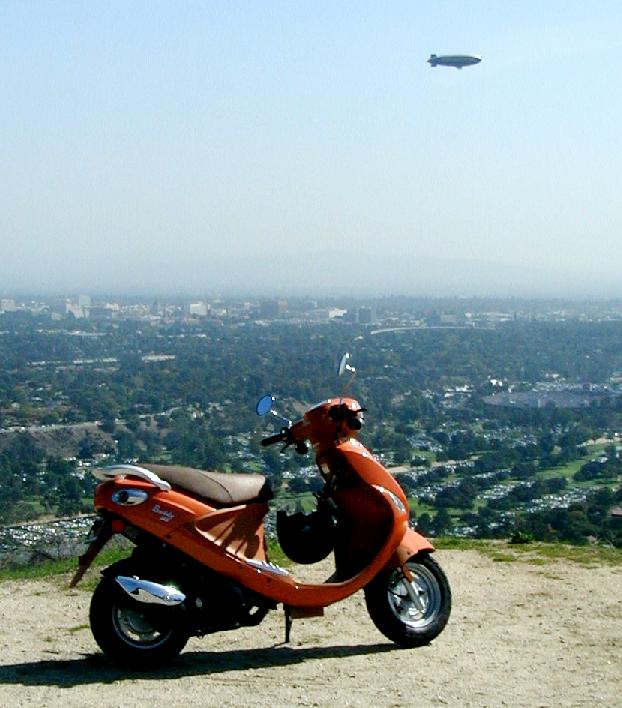[ad_1]
In Europe and Asia, a picture of a busy intersection may well have 15 scooters in it. In the US on the other hand, one may see a single scooter an hour pass a busy intersection. Why is this? Why has this, the ultimate solution to transportation economy been so ignored and neglected in the states? One possible answer is that may people don’t even know what a motorscooter is.

The Motorcycle is more machine than furniture
The motorscooter differs widely in concept from its close relative, the motorcycle. The motorcycle is very clearly a machine – it’s got bits of machine sticking out all over the place, bits of motor showing there, tubes here, wires there, an unmistakable gas tank bloating out and exposed and a great roar is emitted from the engine. Oh yes, it also has a seat and footrests, almost as though they were an afterthought.
Conversely, the motorscooter, is more about the person — the rider and passenger. It’s easy to mount a scooter without having to swing one’s leg over. There is a comfortable floor to put one’s feet on. Driving controls are limited to throttle and brakes – and the brakes are identical in look-and-feel to those of a bicycle. The scoter’s noise output subdued, and the engine, fuel tank, fluids, cables and wiring are all safely tucked away behind designer panels and cowling. The oily, hot, noisy, smelly power of the machine is not a part of the scooter riding experience. Instead, the scooter is more like an elegant piece of furniture whose look and feel is dictated not by the machine below but by aesthetics and the ergonomics of the human interface above. The motorcycle is consciously and unabashedly unevolved though it certainly inspires an atavistic primordial fascination. The motorscooter, on the other hand, exemplifies intelligent evolution.
Motorscooter Economy
With the price of an inexpensive scooter being approximately equivalent to that of twelve tanks of gas in our van, and the glaring statistic that the break-even point – the point at which it would have paid for itself, insurance, and extraneous costs in gas savings — is about 5000 miles, the justification for this frivolous expenditure was irrefutable (See Motor Scooter Economy). Fuel economy and emission reduction alone justify the decision to use motorscooters for local commuting, but the history and image of the motor scooter are also major factors in its acceptance throughout the world and its gradual increase in popularity in the States. See Motorscooter Advantages.
How to Justfy Buying a Motorscooter (to your spouse, parents, or yourself)
This can be challenging. If you are a teenager trying to persuade your parents, a curmudgeon looking for a new experience, or just a parent going through a midlife crisis and trying to persuade her children that she has not gone entirely bananas, a set of persuasive arguments you can use is listed in the Motorscooter Economy page and a Return on Investment analysis calculator is available to determine how long various different scooters will take to pay for themselves given your current car mileage, commute distance, and fuel price.
Cheap Chinese Scooters
It is possible to purchase a brand new street and freeway legal motor scooter online for around $1000. Prices of smaller minimalist non-freeway models and some Electric Scooters are even lower and stand-up scooters run as low as $200 – $300, with high performance and luxury scooters running up to about $2000.
High quality scooters
More established makes, Vespa, Aprilia, Genuine, Honda, Yamaha, and many other companies have excellent scooters for significantly higher prices than the cheaper online, mostly Chinese scooter brands.
One characteristic of inexpensive scooters is that repair costs are naturally going to be more as a percentage of the price of the scooter than would be the case with a more expensive scooter. Though the actual cost of repair may not differ greatly, if faced with a $600 repair prospect (and trouble-shooting can be tricky with any machine), the $999 scooter owner is more likely to opt for a new scooter than is the $4000 Vespa owner. This innate disposability is somewhat unfortunate from an ecological perspective but is definitely a factor in the ownership of an inexpensive scooter in a developed country.
In states outside California, there are many more motorscooter possibilities than in California (see Motorscootering in California) where California Air Resources Board (CARB) approval for vehicles is much harder to get. The California climate is particularly conducive to scooter usage however — the wife of San Deigo’s mayor drives one and their popularlity has increased 300% since 2000 (See Scoot Over San Diego). However, the California freeway system is not particulary scooter-friendly and should be used only with the larger highway scooters.
The Economical Choice
Scooters are such an obvious and elegant solution to simple transportation in a world of steeply rising gas prices. The Italian Motorscooters are excellent, as are Hondas (Japan) and Kymcos (Taiwan) and are the way to go if cost is not a factor. However, as cost so often is a factor in the decision, it is the inexpensive scooters which are most likely to make a motorscooter revoltuion possible and those can be a viable option.
[ad_2]
Source by K. Titchenell

 2/1 Rattanakosin Road,
Si Phum, Muang, Chaing Mai
CONTACT# 0932387148
2/1 Rattanakosin Road,
Si Phum, Muang, Chaing Mai
CONTACT# 0932387148
 19/8 Moo.3 Makham
Tia, Muang, Surat Thani.
CONTACT# 0935790959, 0986716951
19/8 Moo.3 Makham
Tia, Muang, Surat Thani.
CONTACT# 0935790959, 0986716951

